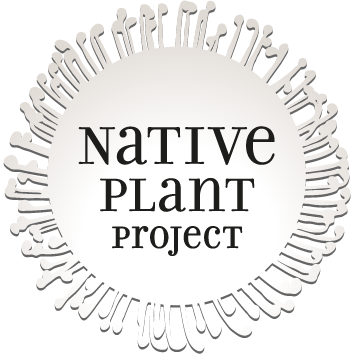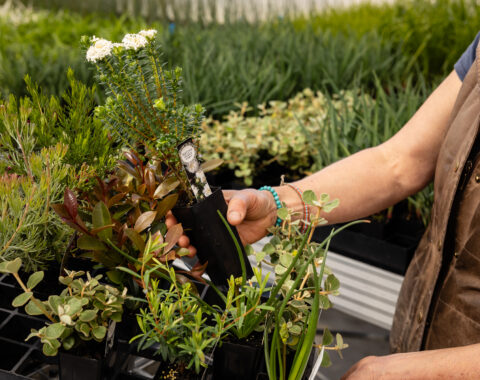- E-Nursery
- WINTER SALE
- Gardens
- The best of Australia’s private and public gardens to inspire your own Native Plant Project large or small.
- Learn
- Tips from native plant experts, growing guides, seasonal gardening diaries and more…
- Projects
- Meet designers, architects, landscapers and creatives engaged in their own native plant projects…
- About
- Contact
When Canadian expat Justin Nigh decided to make a career change away from the IT sector, his fascination with Australian flora and passion for sustainable horticulture led him to establish a design practice specialising in creating native gardens.
A decade on, his residential landscaping practice, Regenerative Designs, is bringing both joy and a sense of place back to people’s front and backyards – with Australian natives front and centre. And it’s a philosophy best expressed in his very own garden on Queensland’s Sunshine Coast.
Native Plant Project chats with Justin on his love affair with natives and how he set about creating this most welcoming of gardens…


Your practice has carved out a speciality designing gardens using native Australian plants. What’s drawn you to working with native varieties?
I’m a Canadian expat, having emigrated from Canada to Australia in 2006, so Australian native plants are ‘new’ to me, a curiosity. That aside, Australian natives are unique with many rare species not found elsewhere. I like that kind of thing. I also have an interest in sustainability and ethical stewardship of the land and find that native plants tick a lot of boxes when it comes to sustainable gardening because they tend to be better suited to Australian conditions which means they require less water, fertiliser, and maintenance than exotic plants. Lastly, I believe only Australian plants can achieve a sense of place that sits well with the natural landscape and is uniquely Australian; I think we should be embracing them rather than trying to be somewhere else.
Do you think people establishing or recreating their front and back yards are growing more receptive to using Australian plants, or does it take convincing?
I make it clear to my clients and those interested in working with me on their residential landscape design that I use a native plant palette in their designs. I’ve found that the majority of people are receptive and don’t take convincing, I believe it’s a case of like attracts like.
“I believe only Australian plants can achieve a sense of place that sits well with the natural landscape; I think we should be embracing them rather than trying to be somewhere else…”



“An important question I always ask is: “Does this space provide a pleasant experience that says ‘welcome,’ or is it one that is simply tolerated until one enters the house?”….
Describe the philosophy behind creating your own garden that celebrates native plants.
My approach and philosophy behind creating my own native plant garden was to use a traditional residential landscape design process and principles but with a native plant palette, rustic materials (corten steel, recycled railway sleepers, hardwood sleepers, recycled concrete, decomposed granite) and sustainable design principles (eg. working with the topography).
Were there any site specific issues you were overcoming and particular effects you wanted to create?
Functionality of the space is always the primary consideration when I design a residential property, especially the front yard. The zones of use given consideration include the property boundary or entry (especially the ‘primary arrival view’ most often seen upon approaching the property), the driveway, the front entry foyer, the front entry walk, and the remaining yard area. These areas of use should be functional, but also pleasant. An important question I ask is: “Does this space provide a pleasant experience that says ‘welcome,’ or is it one that is simply tolerated until one enters the house?”
The effect I wanted to create was a densely planted but open and welcoming front garden with a ‘cultivated wild’ look; curated naturalism but not chaotic. I prefer to focus on the form and texture of plants first and foremost, with restrained but tactical use of colour and flowers (to achieve certain design effects or focal points), which can be fleeting.
Because the house sits lower than the front yard, I wanted to divert surface water flow around the foundation to the backyard where it could be collected and put to use within the garden. I achieved this by creating a small diversion swale to catch and redirect water to the backyard where it’s picked up by other swales which are planted with fruit trees.
Plants had to be suited to the local SE QLD climate, and able to thrive on rainfall as I didn’t want to provide supplemental watering for conservation and maintenance reasons. The garden encompasses the front yard of a 975m2 block. Total garden area is about 120m2.




“I wanted to create a densely planted but open and welcoming front garden with a ‘cultivated wild’ look; curated naturalism but not chaotic. I prefer to focus on the form and texture of plants first and foremost, with restrained but tactical use of colour and flowers…”
What tips would you provide for anyone contemplating creating a ‘true’ Australian garden design of their own?
Use an Australian native plant palette, of course! Preferably plants local to your garden but not exclusively; as long as they suit the environmental and soil type and conditions of your garden. Choose a restrained palette of 8-10 different plants of varying height/type (eg. tree, shrub, groundcover, climber) for a layered effect, plant in groups and swathes/drifts, repeat plant groupings through the garden to help create unity, a key principle of garden/landscape design.
Are there some favourite varieties you enjoy working with in your residential designs?
Some of my favourites for front and backyards include: Doryanthes excelsa, palmerii; Lomandra longifolia, hystrix; Crinum pedunculatum; Westringia ‘Mundi,’ ‘Smokey,’ ‘Peppermint Cream’; Melaleuca ‘Mini Quini’; Anigozanthos ‘Landscape Gold,’ ‘Landscape Scarlet,’ ‘Landscape Tangerine’; Themeda triandra; Leptospermum petersonii, brachyandrum, polygalifolium; Banksia spinulosa; Banksia integrifolia; Corymbia citriodora ‘Scentuous’; Eucalyptus curtisii; Melaleuca nodosa; Lomatia silaifolia; Pultenaea villosa

















